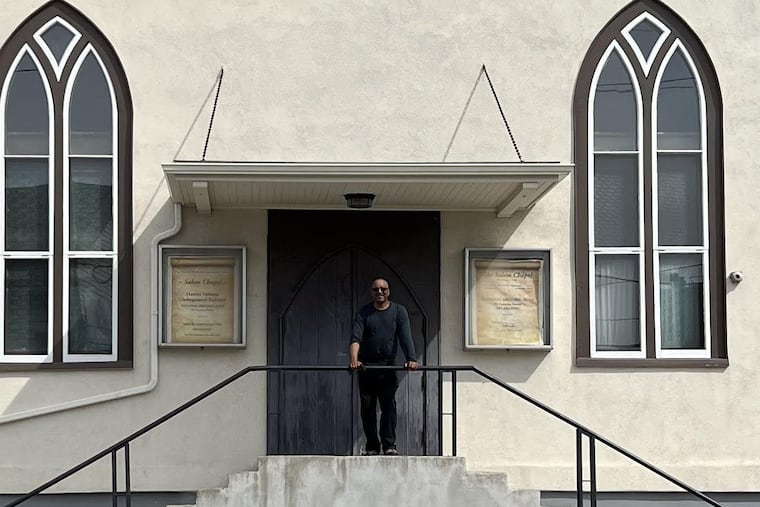Philly ‘walking artist’ arrives in St. Catharines, Ontario, where Harriet Tubman once lived
Ken Johnston, Philadelphia's "walking artist" who started a walk from Harlem to Canada in July, arrived at St. Catharines, Ontario, on Saturday. He was walking to honor Harriet Tubman.

Ken Johnston, the Philadelphia “walking artist” who set out from Harlem, N.Y., in July, walked across the Rainbow Bridge into Niagara Falls, Ontario, shortly after sunrise Saturday.
By Saturday afternoon, he arrived at his destination: St. Catharines, Ontario, the city where Harriet Tubman, perhaps America’s most famous Underground Railroad leader, lived between 1851 and 1861, before the start of the Civil War.
Johnston, 61, of Cobbs Creek in Philadelphia, ended his approximately 450-mile walk at Salem Chapel British Methodist Episcopal Church, where Tubman once worshiped.
Reached by phone Saturday, Johnston said he was both excited to have arrived in Tubman’s former city — and exhausted:
“The last three miles today, it got very, very warm. It was hot. .… But I was pretty exhausted when I got here.”
“It’s really exciting to make the complete journey she traveled,” he said, referring to Tubman’s starting point in Maryland.
“I have so much respect for Harriet Tubman and just how far and how much of herself she gave to rescue so many people over 800 miles from Maryland’s Eastern Shore.”
He had walked this year to honor the 200th anniversary of Tubman’s birth.
The New York-to-Canada walk is a continuation of two earlier walks Johnston made, from Poplar Neck, Md., near Tubman’s birthplace in Dorchester County, which he began in December 2019, to Philadelphia, in February 2020.
Due to COVID-19, Johnston did not walk from Philadelphia to New York until April 2021.
He also made a separate, 165-mile walk tracing the South Jersey routes of the Underground Railroad earlier this year, from April to May.
Richard Pierpoint meets Harriet Tubman
About a half-mile before he got to Salem Chapel, Johnston walked by Richard Pierpoint Park, named for a Black man who had been enslaved in the American colonies.
Pierpoint gained his freedom, and 200 acres in Canada, in exchange for fighting for the British during the American Revolutionary War.
Johnston said he found it important to connect the stories of Pierpoint and Tubman, who led several groups of enslaved people to Canada on the Underground Railroad.
As a “walking artist,” Johnston is part of a network of people who use walking as an art practice in a variety of disciplines.
“My canvas might be 5 miles wide and 450 miles long. Across that time and space, I’m filling in with stories. I’m not a historian, but I build stories along the way and connect them.”
He said seeing Pierpoint Park reinforced how different stories come together.
“She [Tubman] just didn’t come anywhere [when she fled to Canada],” Johnston said. “She came to a place where there was an established Black community. “
Tubman’s home in Canada
When Tubman lived in St. Catharines, she brought her parents and a brother to live with her in a rented house on North Street. She continued to carry out missions to free Black people in the United States.
In 1859, Tubman moved her parents and a brother to Auburn, N.Y. According to Natasha Henry, writing for the Canadian Encyclopedia, her parents were not happy with the cold Canadian winters.
However, for a while, she continued to work from Canada, planning rescues and establishing a Fugitive Aid Society to support Black refugees from the States.
In 1862, she traveled to South Carolina and joined the Union forces as a nurse and a spy during the Civil War.
Salem Chapel ties to Richard Allen and Philadelphia
The church where Johnston ended his walk was built in 1855, to accommodate a growing community of free Black and formerly enslaved people.
Black people had begun settling in St. Catharines in 1788, the church website said.
The original Salem church was built in 1829 as an African Methodist Episcopal Church, affiliated with the AME church of Philadelphia’s Richard Allen.
However, after the Fugitive Slave Act of 1850, Black Canadians could not risk traveling to AME Conferences in the United States. The church became affiliated with the British Methodist Episcopal Church.
At the church Saturday, Vicki Smith, a Black Canadian, was among those who welcomed Johnston.
Smith said her great-great-grandfather, Adam Nicholson, had been an enslaved Black American, who fled to Canada on the Underground Railroad.
She said she only learned about Johnston’s walking projects a couple of days ago from a member of Salem Chapel.
“I think it’s amazing,” Smith said. “I think more attention needs to be put on this in Canada. They don’t teach this in school, and I feel like they should.”